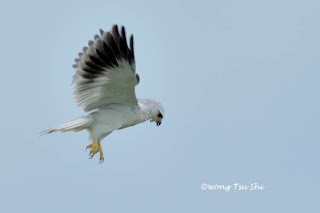First we got this Black-headed Gull Larus ridibundus (my lifer) at Tanjong Aru at late afternoon, when the sky was heavily overcast and a storm was brewing. There were about ten of them there, in winter plumages and mostly first winter birds, flying above the shallow sea occasionally diving for the surface for food.
Black-headed Gulls are very scarce winter visitor to coast of northern Borneo, however, despite scarce, they are quite regular along coasts of Sabah during the migratory season.
Black-headed Gull
Common Teal is a vagrant of Borneo, 4 records before this, only one from Sabah at Padas Damit in December 1984. This is the second record in Sabah.
Common Teal - Male (top), Female (bottom)
Common Kingfisher
Hoping to have a glimpse of the Buff-banded Rail Gallirallus philippensis, Tampasok plain was our next destination, this bird too was not seen but the place was rife with activities.
A group of otherwise foraging Black-winged Stilt Himantopus himantopus took flight, flashed by the fastest raptor in the world from above, the migratory Peregrine Falcon Falco pereginus, who was looking for lunch.
Black-winged Stilt
Its lunch was an unlucky White-breasted Waterhen Amaurornis phoenicurus. Peregrine Falcon
Yellow Wagtail
A hovering Black-winged Kite Elanus caeruleus was looking for lunch as well.
Black-winged Kite
Chinese Egret
Chinese Egrets are uncommon winter visitor to Borneo, IUCN red list status is vulnerable due to lost of habitats to human economic activities.
Happy birding.
Photodocument of Wild Birds of Borneo
Standard References for my blog



















